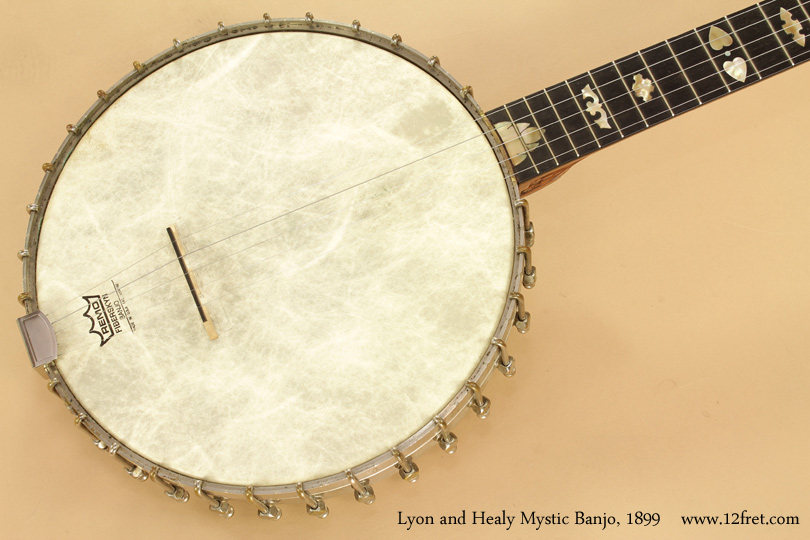Lyon And Healy Banjo Information
In 1864 George Washburn Lyon and Patrick J. Healy were sent to Chicago by Oliver Ditsonto set up his Mid West musical instrument wholesale business and among their suppliers was C F Martin. In 1880, frustrated with the lack of volume available from some of the makers, including Martin, they broke away from Ditson, and in 1883 set up a manufacturing business which included banjos, mandolins and a few. From the hallowed halls of the New York Philharmonic to the Bolshoi Ballet, Lyon & Healy Harps is acclaimed throughout the world for its remarkable depth and clarity of sound, breathtaking designs, and rich heritage of quality craftsmanship. With 130 years of harpmaking experience, each hand-crafted pedal and lever harp is instilled with a legacy of superior woodcrafting and commitment to the development.
Welcome to
This website is dedicated to photos and descriptions of the many banjos in my collection, along with a few other vintage instruments I have picked up over the years. I have authored this site in the hope that other collectors might follow suit and share photos and information on their banjos with others in the collecting community. Since my interest in banjos stems in part from my interest in the technological development of the instrument over the years, my collection spans the period from the 1840’s to the 1920’s. As my collection evolves, banjos presented on the home page of this site may be removed and added to a 'banjos I previously owned' page. Banjos in my current collection are listed alphabetically by manufacturer or brand name. I have recently added a page on Fairbanks/Vega engraved inlay evolution for those interested in how this particular art form developed over the years and through the transition from Fairbanks to Vega ownership. For those interested in the genealogy of banjo manufacturers, I have included a page summarizing some important relationships between manufacturers, but much better information is available elsewhere (see, for example, America's Instrument, The Banjo in the Nineteenth Century, by Gura anad Bollman, University of North Carolina Press, 1999). For those interested in finding out more about buying vintage banjos and other vintage stringed instruments, I have included a page on that as well. I have also included a page on identifying unmarked banjos, for those who have an instrument of unknown origin. For those wondering where I put all of these instruments, I have added a page on living with vintage instruments. This should be particularly helpful to those collectors trying to convince dubious spouses that they don't already have too many banjos. Finally, I have added a page dealing with maintaining and restoring vintage banjos and other vintage stringed instruments. Also, click here for an example of how one can go too far to restore a banjo. For questions and comments, please contact me (Bill Destler) at bill.destler'at'rit.edu.(substitute @ for 'at').
Banjos
Bacon
Bacon 'Professional FF Special' 5-string banjo, Circa 1913
Boucher
Buchanan
Buckbee
Burkard
Cole
W. A. Cole “Eclipse” 5-string banjo model 5000, S/N 3600, Circa 1897
W. A. Cole “Eclipse” 5-string banjo, model 3000, S/N 3670, Circa 1897
W. A. Cole “Eclipse” 5-string banjo model 4000, S/N 3959, Circa 1897
Cubley
G. H. Daniels
C. E. Dobson
G. C. Dobson
H. C. Dobson
Eibel(click here for new information on Eibel banjos!)
Fairbanks & Cole
Fairbanks
A. C. Fairbanks “Senator No. 1” 5-string banjo, S/N 21028, Circa 1901
A.C. Fairbanks “Whyte Laydie” No. 7, 5-string banjo, S/N 22616, Circa 1903
Fairbanks (by Vega)
Farland
Farris
J. Farris “E&F Tenor Banjay”, Amateur Grade 2-1/2, Circa 1880’s
Gatcomb
Haynes
John C. Haynes 'Bay State' 5-string banjo, model 323, Circa 1890

John C. Haynes “Bay State” 5-string banjo model 354, Circa 1890
Lyon & Healy (including Washburn banjos)
'George Washburn' 5-string banjo, model 421 custom, Circa 1892

'George Washburn' 5-string banjo, model 442, S/N 328, Circa 1892
Magez
Morrison
Quinlan
Rettberg & Lange (including Orpheum banjos)
'Orpheum #3', 5 string banjo, S/N 9079, Circa 1915
'Orpheum #3 Special', 5-string banjo, S/N 13406, Circa 1919
Robinson
Rudolph
J. B. Schall
J.B. Schall (Denzel) “Peerless” 5-string banjo Circa 1895
S. S. Stewart
S.S. Stewart “Thoroughbred” 5-string banjo, S/N 6096, Circa 1890
S.S. Stewart “Little Wonder” piccolo banjo, S/N 6265, Circa 1890
Stratton & Handley
Stetson
Talmadge
Teel

Teed
Thompson & Odell (including Luscomb banjos)
Todd
Turner
Weymann
Focusing eugene gendlin pdf. Weymann 5-string banjo Circa 1900’s
Wilkes
Windsor
Unmarked, Minstrel, and Folk-Art Banjos
Other Vintage Instruments
Guitars
Lyon And Healy Banjo Information Company
C. F. Martin guitar, 0-42, S/N 12929, Circa 1916
Mandolins
Miscellaneous
Lachenal English concertina, SN 43576, Circa 1890
Lyon And Healy Banjo Information Center
Lyon and Healy is a musical instrument manufacturer that still operates in Chicago. Formed in 1864, Lyon and Healy opened a factory at Randolph and Ogden in 1890 that is still operation.
Known for their harps, they have also at times made guitars, banjos, pianos, and other musical instruments.24 In 1913, the factory depicted on the postcard was opened (designed by Hyland and Green). Located on Fullerton just west of Pulaski (then Crawford), along the Milwaukee Road line, the factory included a station along the railroad named after the complex; the station is still called Healy to this day.25
Lyon & Healy Banjo
The Lyon and Healy factory on Fullerton did not remain in operation for long; by the 1930s, it was home to the Mills Novelty Company, a noted coin-operated machine manufacturer.26 The usual model of industrial de-concentration would suggest that the company would have closed their original factory on the Near West Side and made the Fullerton location their main operation. In actuality, the Fullerton operation did not last twenty years, and the firm’s 100+ year old Near West Side factory still remains in operation to this day! This serves to demonstrate that there are often prominent exceptions to any theoretical model.
Lyon And Healy Banjo Information List
The factory remains in good condition today (aside from its window treatments), and is used as a public storage facility. Various additions to the site were made over the years, as the buildings that comprise the site today are larger and more numerous than those depicted in the postcard.